You’ve probably seen this many times: a person sitting at a metal table at a hole-in-the-wall eatery, face held parallel to the plate or bowl in strong focus. In Vietnam, food isn’t just nutrition, it’s a philosophy – beautiful, complex and simple all at once.
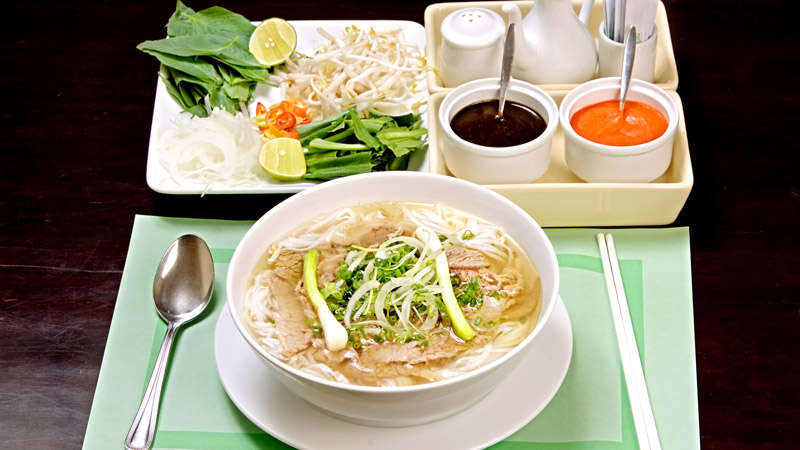
Image source: kenh14.vn
And lucky you – you can experience it yourself.
A Family Affair
Vietnamese� food is not just an assortment of ingredients made in a specific manner. That’s a recipe, not a cuisine. At its most fundamental, Vietnamese food is both an idea and an experience.
First and foremost, it’s a cuisine that celebrates the idea of family. As the writers of� Golden Spoon & the Quintessence of Vietnamese Cuisine point out,
“In Vietnamese culture, the family meal is always something holy. It is not only a place for reunion, but also a moment for connection, sharing [and] warmth that everyone saves for each other.”
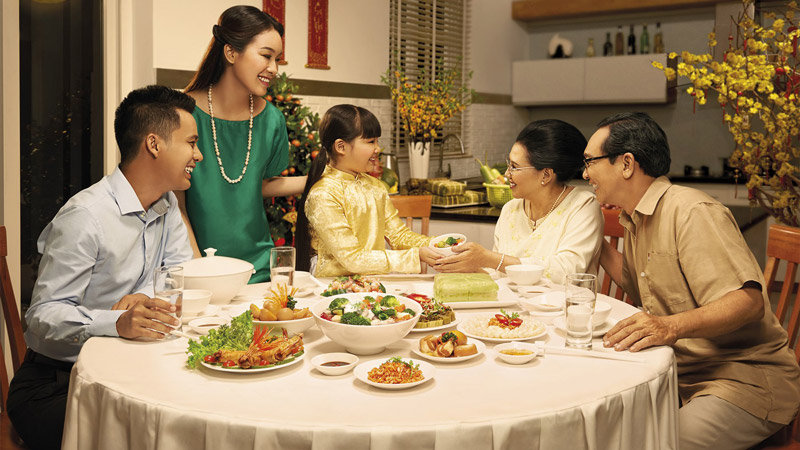
Image source: vicare.vn
Walk around� Saigon’s streets at night, and you’ll see this happy communion of souls at many a� bia hoi and sidewalk restaurant: large groups laughing, shouting and cheersing over gigantic, family-style spreads of stir fries or communal hot pots.
The Spice of Life
However, what is most integral to Vietnamese food? For renowned Vietnamese chef Chiem Thanh Long, it comes down to spices. Chef Long is quick to note that� spices aren’t just used to add flavour.
Spices are part of a complex system of health that’s grounded in the concept of yin and yang, the idea of contrasting-yet-complementary forces that work to make a beautiful and balanced whole.
For example, in Vietnamese cuisine, duck is almost mandatorily paired with ginger. This isn’t just because these tastes work well together. “Duck is ‘yin’, or cool, and ginger is ‘yang’, or hot. They balance out, so that when a person eats too much duck, their stomach is not upset by too much ‘yin’.”

Look at your next Vietnamese menu and you’ll start to see this pattern. Sauteed morning glory (yin) and garlic (yang). Snakehead fish (yin) and� piper lolot (yang). This delicious list goes on.
No Set Cuisine
It’s a shame just how little the nuances and varieties of Vietnamese food are celebrated across the globe. “Before I came to Vietnam, I had no idea about the food! All I knew was pho and banh mi.” Mark Lowerson, food blogger and street food tour guide in� Hanoi, recognises this unfortunate oversight in much of his clientele: “A lot of people will maybe know about pho, but maybe won’t know the difference between a Vietnamese and Chinese spring roll. And it’s always a revelation.”
Even Vietnamese locals have been humbled by the complexity.� Ly Sang, who organises the yearly national cooking competition the Golden Spoon Awards, told us,
“I thought I knew a lot about Vietnamese cuisine, and then I started travelling the country [for the competition]. I realised I hadn’t even scratched the surface!”
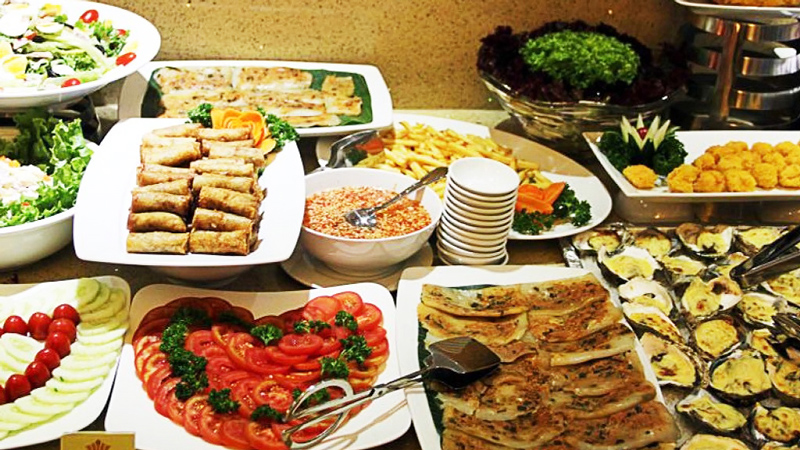
Image source: smiletravel.vn
After all, the� bun cha in Hanoi is remarkably different from the� bun cha on offer in Saigon. Each region lays proud claim to unique styles, tastes and spices. Chef Chiem Thanh Long says, “Nowadays people in Saigon eat less sugar, but it’s supposed to be sweet still… In the central [region], it’s salty and spicy. In the north, chefs try to keep the natural state of ingredients.”
And thanks to Vietnamese chefs’ penchant for using only fresh, locally sourced ingredients, a region’s cuisine naturally depends on the herbs, spices and produce that thrive in each of Vietnam’s dramatically differing climates. For the savvy gourmand who wants to understand the nuances of Vietnamese cuisine, here’s our list of must-tries in North, Central and South Vietnam.
Northern Specialities
Sapa: Thang Co and Com Lam
With perhaps the most unique menu on our list,� Sapa’s mountainous region has naturally developed a very specific set of ingredients to work with. We recommend two rustic dishes cooked and enjoyed by the Hmong people: thang co and com lam.
Thang co is a hearty stew that pairs many parts of a horse (bone, viscera, meat) with a veritable medley of spices like cardamom, ginger, cinnamon and citronella. Making� thang cois a labour-intensive process taking at least a couple of hours for all the flavours to blend. But when they do, get ready for something special. It’s typically served with a hot red pepper from Muong Khuong.
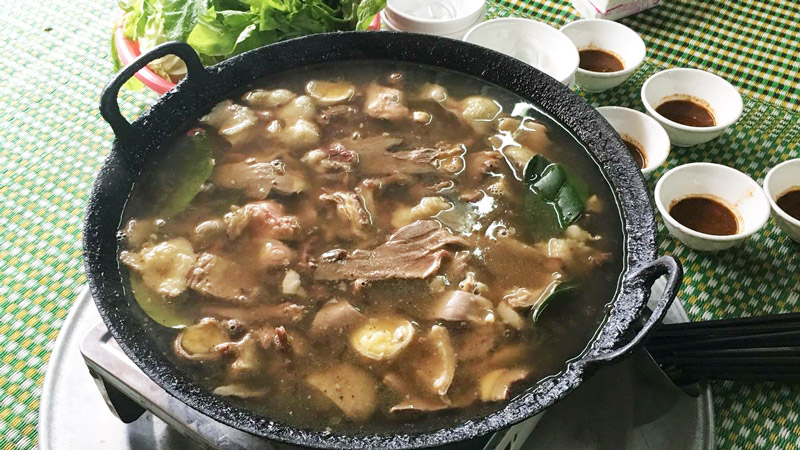
Image source: lozi.vn
To accompany your� thang co, go for com lam, or bamboo sticky rice. Locals fill individual sections of bamboo with rice and add a bit of salt and water, and steam the rice directly in the bamboo, which makes for a delicately sweet, salty and chewy accompaniment to any meal.
Grab a piping hot bowl of thang co at weekend fairs in Sapa, as well as� Nha Hang Kham Pha Viet (15 Thach Son, Sapa).
Hai Phong: Nem Ran and Banh Da Cua
This industrial business town isn’t seen as very touristy, but it has incredible seafood. Crabs are usually on the menu, which they cook up adeptly for Hai Phong’s famous� nem ran, a decadently big, fried, square spring roll traditionally cut into quarters.
Many restaurants mix the crab meat with minced pork, egg, mushroom and onion and wrap this in a special rice paper from Hai Phong to give these heavenly crab pillows the perfect amount of crunch. These can be served as an appetiser, or along with greens and vermicelli if you want to make a meal of it (recommended).
Once you’re done with your starter, it’s time for your main course:� banh da cua. The wide, flat, brown noodles found in Hai Phong are here paired with wilted spinach and morning glory, tomato and crab balls. Over this delightful concoction the talented chef will pour a seafood-based broth. The flavours are relatively mild, and the textures provide a satisfying chew.
Check� 264 Cho Hang and� 26 Ky Dong in Hai Phong for these dishes done right.
Hanoi: Ca Cuon Thit, Bun Cha
On our “spring rolls done differently” tour, we come to Hanoi’s little-known ca cuon thit. This is simply a gem within a gem: at its core, there’s a mixture of pork and wood mushrooms; wrapped around this, flakes of succulent perch; and around this, different types of flour mixed with dill, deep fried to perfection. And when you add the obligatory fish sauce for dipping? Heaven in a bite.
We now come to the place of origin of� bun cha. Part of the DIY variety of food so popular in Vietnam, a steaming plate of� bun cha will allow the diner to create a soup made from diluted fish sauce (usually accompanied with pickled veggies), a mountain of greens, a mass of vermicelli noodles and bite-sized hunks of beautiful, flame-grilled pork. The most difficult part is finding the best� bun cha place in Hanoi: there are too many!
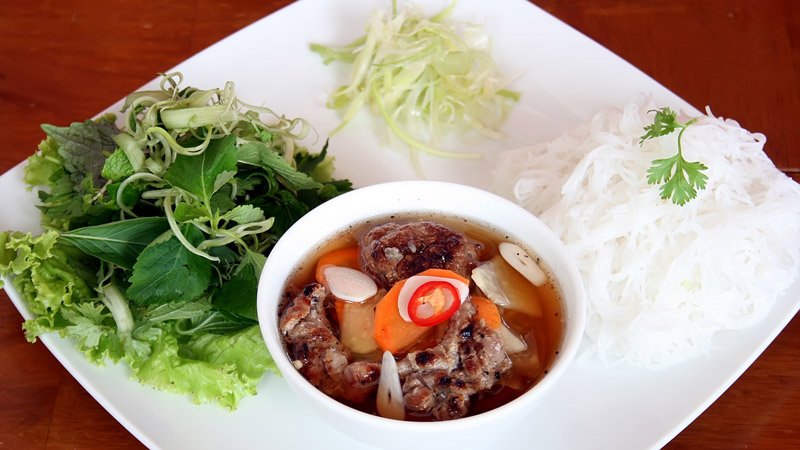
Image source: mevacon.com.vn
Ca cuon thit� is difficult to track down in Hanoi, but check� Bun Ca Sam Cay Si (5 Trung Yen). The best bun cha restaurant is a matter of dispute, but� Bun Cha 34 Hang Than (34 Hang Than) is popular with the locals – always a good sign.
Central Specialities
Hue: Bun Bo Hue and Com Hen
Perhaps the most celebrated food destination in Vietnam is� Hue, which houses a long food history, deeply intertwined with past royalty. It’s said that rulers in the 19th century demanded a new dish every day of the year, forcing the royal chefs to come up with hundreds of distinct and intricate culinary delights.
The quintessential Hue delicacy remains the rustic bun bo hue – not a very regal dish, but absolutely delicious nevertheless. As Tai Dang, tour manager of Saigon’s XO Tours told us, “The broth is different. For pho, the broth is beef or chicken. For� bun bo hue, the broth is beef and pork, and flavoured with lots of lemongrass.” These subtle differences make for a notably different eating experience. When paired with the� huyet� (cubes of congealed pig’s blood), water spinach, morning glory and bean sprouts, it’s hard not to order a second bowl.
Another Hue dish is� com hen, or mussel rice: steamed rice accompanied by tiny mussels, a variety of shredded greens and the obligatory spicy chili fish sauce. Traditionally this is seen as a dish enjoyed by commoners, but who cares? It’s amazing.
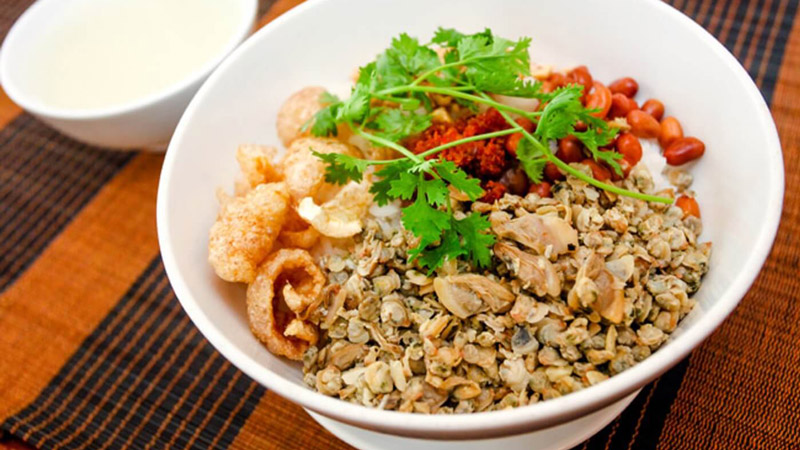
Image source: vanhoaviet.com
Head over to the very local� Quan Bun Bo Hue Restaurant (19 Ly Thuong Kiet) for your first course, and then nab some� com hen at� Quan Nho (28 Pham Hong Thai).
Danang: Mi Quang and Bun Cha Ca
One of the most distinctive Vietnamese noodle soup dishes around, you won’t get better� mi quang than in its place of origin,� Danang. The solid base of this hearty soup is the healthy dollop of turmeric-infused rice noodles, with a mad creativity of proteins that can include shrimp, pork, chicken, and sometimes fish and beef. Just as likely to be floating in your little bowl of paradise are crushed peanuts, hard-boiled egg, a large shard of sesame rice cracker and, our favourite part: a delightfully fresh and crunchy plate of thinly minced vegetables.
If you want more, it’s time for� bun cha ca. Danang is famous for its fabulous, fresh seafood, and this is truly displayed by the� cha ca (fish cakes), traditionally savoured for breakfast. This noodle soup dish pairs these delicious cakes with slices of lemons and chilies, fermented shrimp paste (just try it!), with vegetables like pumpkin, pineapple, tomato and cabbage.
For� mi quang, you can’t go wrong at� Ba Vi (166 Le Dinh Duong). For� bun cha ca, there’s a great eatery on� 109 Nguyen Chi Thanh.
Southern Specialities
Nha Trang: Lac Canh and Bun Ca Sua
There’s a saying: “If you come to� Nha Trang and don’t try the grilled beef lac canh, it means you only know half of Nha Trang.” What really makes� lac canh special is the marinade. They infuse the beef with a mixture of honey and spices and then grill this pairing over charcoal. It’s served with bread or raw vegetables.
Just as integral to Nha Trang’s cuisine landscape is� bun ca sua – seafood soup. Of course, variations of seafood soups exist up and down the coast, but few take advantage of the jellyfish roaming Nha Trang’s seas. They’re definitely an acquired taste, but worth trying.
To get your fill of� lac canh, visit� Nha Hang Lac Canh (44 Nguyen Binh Khiem). For bun ca sua, there’s none better than� Ba Nam (50 Thong Nhat). Bon appetit!
Saigon: Com Tam and Banh Canh
Saigon is a bit of a food mystery. As Tai from XO Tours tell us, HCMC is routinely referred to as “the house of food” with delicious dishes from all over Vietnam. However, there aren’t many Saigon-specific specialities. As Chef Chiem Thanh Long confirms, “Actually, there is no food that is typical of Saigon. Whether you want to eat the food of Central, Northern, Central Highlands or Southern regions, all are here in Saigon. Saigon and Dalat are similar in that sense, collecting so many dishes without a typical dish of its own.”
Bearing that in mind, you can get some seriously delicious fare here. Take the quintessential southern� com tam, for instance. While broken rice was originally fed to livestock, today its soft, delicate texture lends itself well to the paired egg, meat (usually pork) and pickled vegetables.� Com tam is meant to be sweet, like a lot of food in Southern Vietnam. Definitely soak the rice in fish sauce, not soy sauce.
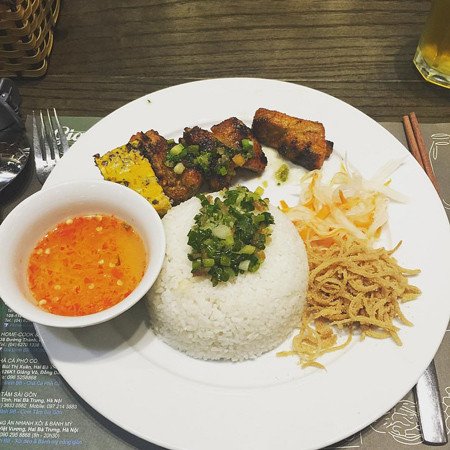
Image source: flickr.com
Another dish you’d be crazy to pass up is� banh canh. With perhaps the thickest of all Vietnamese noodles, the beauty of� banh canh lies in its variations. Depending on the city, or even the restaurant, you can get shrimp, pork or fish cake with it. In the Mekong Delta, be sure to keep your eyes open for� banh canh made with coconut milk.
There’s no “best”� com tam, but Tom Divers of Vietnam Coracle recommends� Com Tam 352(352 Chu Van An, Binh Thanh D).
For� banh canh cua (with crab), we’ve heard good things about� Banh Canh Cua 87 (87 Tran Khac Chan, D1).
Mekong Delta Region: Hu Tieu and Fried Elephant Ear Fish
As the farming capital of Vietnam, the� Mekong Delta is virtually exploding with delicious food. Here there’s a multitude of everything: fruit, vegetables and animals. Take, for example, the always-lovely fried elephant ear fish available at restaurants and homestays.
The presentation is half the fun, as the fish is traditionally propped up, so hungry guests can take the meat from both sides at once. Paired with lettuce and a sauce for dipping, this is definitely one of the freshest fried foods around.
Hu tieu is another beautifully balanced dish – a medley of different meats from land and sea are paired with a clear, subtle broth, vermicelli noodles and a lot of seriously fresh vegetables. This dish has many changing faces: it can be served dry as well as in a soup, and the additives change depending on each chef’s speciality.
Nha Hang Song Nuoc Mien Tay (52-53 to ban do so 18, ap 3, xa Tan Thach, Ben Tre) has great fried elephant ear fish if you want this tasty treat, and� Hu Tieu Binh Dan Ba Sam (188 Tran Hung Dao, Sa Dec) has been named the best hu tieu in Southeast Asia (and a bowl is only VND6,000!)
Understanding the Vietnamese Table
You might not be familiar with all the sauces at a Vietnamese table, but have no fear! Tai Long from� XO Tours gives us a briefing.
Utensils
Chopsticks are used for a lot of dishes, but you’ll also see forks and spoons. Spoons are essential for eating rice and even cutting meat. Use the chopsticks in your right hand to push the food on the spoon, held in your left hand. If you eat rice with a fork, you might be laughed at.
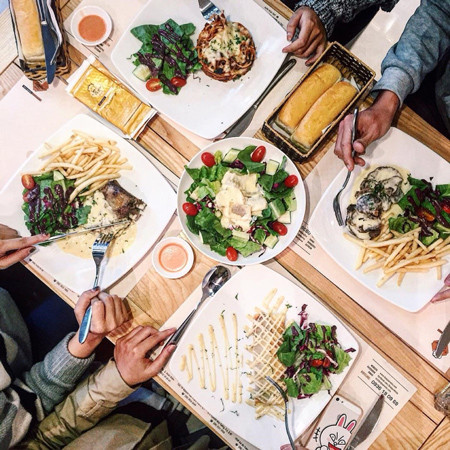
Image source: zing.vn
Limes, Peppers and Sauces
Chances are you’ll be presented with a small dish of limes, banana peppers (spicier than the red flakes!) and sauteed red peppers in oil. Use as little or as much as you’d like – one of the great things about Vietnamese cuisine is that it’s easily customisable. If a soup broth is too salty (broths tend to get saltier as the day goes on), add some lime to even things out.
Etiquette
Tai says, “When you’re drinking soup, don’t make so much noise. And don’t put your elbows on the table. It’s rude.” If you’re having dinner at a traditional Vietnamese house, wait before being served: sometimes elders and men are served before all others as a sign of respect, although this tradition is waning. If you want to show your host you’re a happy eater, there’s no better way than to eat everything. “Clean your bowl,” Tai says. “And don’t be afraid to pick up your bowl and drink from it. It means you’re enjoying it.” With the food in Vietnam, that won’t be a problem.

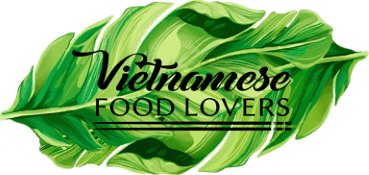
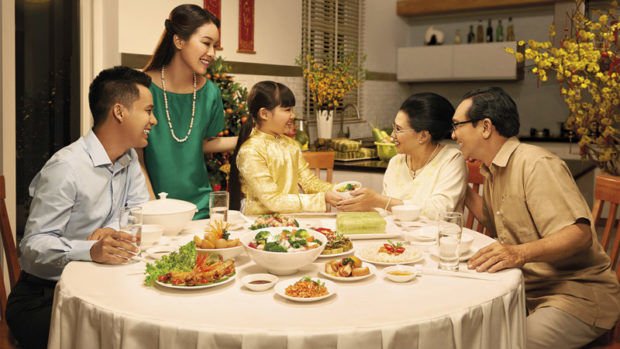
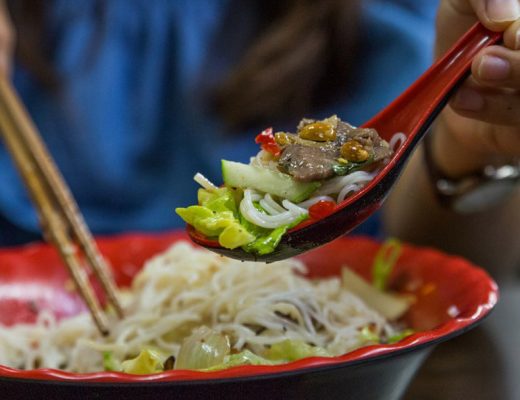
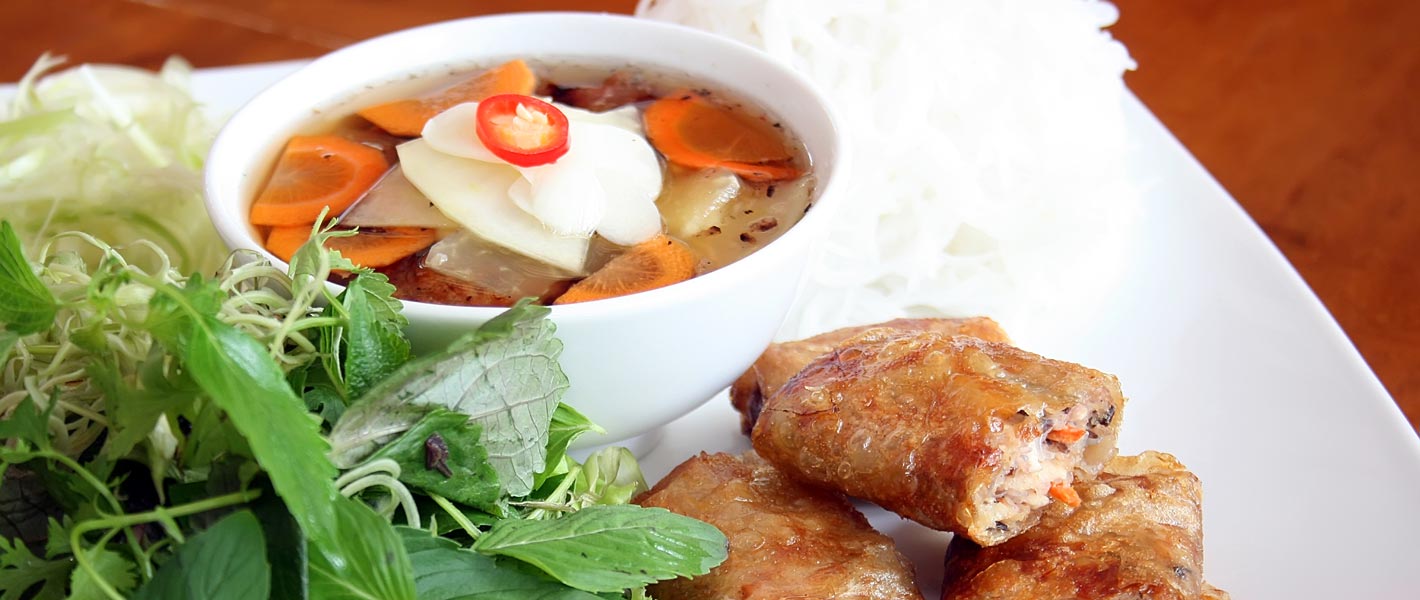
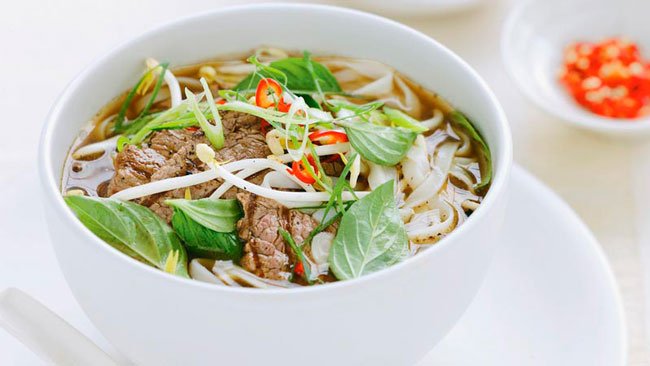
No Comments